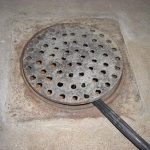When building or renovating your driveway, it’s important to consider installing a drainage system underneath it. While the installation process may not be difficult, choosing the right type of pipe can be challenging. With so many options available in plumbing stores, it’s easy to feel overwhelmed and unsure of which pipe to choose.
Ideally, you should use PVC or corrugated drainage pipes for installing under the driveway. These pipes are the toughest on the market and offer greater flexibility and improved drainage capacity. By using these types of pipes, you won’t have to worry about damaging your automobile or clogging the home entrance on the driveway. In this article, we’ll take a closer look at what to consider when installing drainage under your driveway.
What Type of Drainage Pipe To Use Under Driveway?
When it comes to building a drainage system under your driveway, you need to choose the right type of outdoor drainage pipe. The two most popular options are PVC and corrugated pipes. In this section, we will explore these two types of drainage pipes to help you make an informed decision.
1. PVC Drainage Pipe:
PVC drainage pipes are a common choice for both indoor and outdoor drainage systems. They are ideal for driveway drainage due to their rigidity and ease of cleaning. PVC pipes are made of synthetic plastic polymers and come in various types, including:
- PVC-U pipes, which are unplasticized and extremely rigid, making them a great choice for driveways.
- C-PVC pipes, which are chlorinated and offer impact, corrosion resistance, durability, and reliability.
- PVC-O pipes, which are an improved version of PVC-C pipes and offer better performance and durability in extreme conditions.
2. Corrugated Drainage Pipe:
Corrugated drainage pipes have grooves and ridges that run parallel to the pipe’s installation. They are perfect for bends and joints and are an affordable solution for easy drainage installation under the driveway. HDPE/N 12 corrugated dual-wall drainage pipes are the most popular type of corrugated pipe for drainage due to their high-density polyethylene material, which provides excellent rigidity and strength.
3. Perforated Drain Pipe Under Driveway:
Perforated pipes can be either corrugated or solid and are designed to remove rainwater and excess water from outdoor areas such as yards and lawns. They are suitable for driveways due to their improved draining capacity, rigidity, and performance. Perforated pipes have tiny holes and slots around their entire surface, allowing water to enter and exit easily.
Perforated drain pipes are ideal for regions with heavy rainfall and can help maintain your property by reducing the possibility of standing groundwater. However, they require more maintenance than other types of drainage pipes and are slightly harder to clean and unclog.
In summary, when choosing a drainage pipe for your driveway, consider factors such as the amount of rainfall in your area, durability, rigidity, and ease of maintenance. PVC, corrugated, and perforated pipes are all suitable options depending on your specific needs.
Factors to Look At For Drainage Pipe Under Driveway
Temperature Changes:
When selecting a drainage pipe for your driveway, it is important to consider the temperature changes in your area. Extreme temperatures, especially in cold seasons, can affect the performance of the pipe. PVC pipes may not be the best choice in areas with sub-zero temperatures, as frozen water can damage them. Perforated pipes with tiny holes may be a better option in these conditions.
Amount of Drainage Water:
The amount of water that needs to be drained from under your driveway is another important factor to consider. The size and diameter of the drain pipe will depend on the expected drainage water amount. A larger diameter and size, such as a ½” PVC pipe, will be able to drain more water than a smaller 5/8” drain pipe.
The Weight of Your Vehicle:
The weight-bearing capacity of the drainage pipe is crucial since it will be located right under your driveway, and your vehicle will pass over it multiple times a day. The weight of a vehicle can vary from 2500 to 4500 pounds, depending on the type of vehicle. Therefore, it is important to select a durable and sturdy material that can withstand the weight of your vehicle for years without damage.
Overall, when selecting a drainage pipe for your driveway, it is important to consider the temperature changes, drainage capacity, and weight-bearing capacity. PVC, perforated, and corrugated drainage pipes are all options, but it is essential to choose a pipe that is reliable, sturdy, and resistant to corrosion and erosion. Reinforced concrete pipes may be a safe choice, but they can be expensive. Ultimately, the selection should be based on the quality, wear resistance, and price of the materials.
How To Run Drainage Pipe Under Driveway
If you want to install a driveway drainage pipe, you need to follow a few steps. You will need a shovel, trench digging machine, driveway drainage pipe, gravel, and drain grate. Here are the steps to follow:
Step 1: Outline the Draining Plan
Firstly, you need to measure and outline the driveway culvert draining plan. You should use a measuring tape to measure the depth and length of the pipe. Make sure it is not too close to your home foundation or the road, and it should not be too visible from the ground.
Step 2: Create the Trench
Once you have outlined the draining plan, start digging the trench. If it is a small driveway with creek and gravel, you can use a shovel. However, if you need to dig a deeper and longer trench, you will need to use a trench-digging machine. If you don’t have one, you can call a plumber or construction worker for it. Smoothen the trench surface to sit in the draining pipe. Also, look for any objects that might damage the pipe inside the drainage and remove them carefully.
Step 3: Install the Pipe
After creating the trench, you should lay the draining pipe slightly. The angle will help the pipe drain naturally without working against gravity. If you need a longer drainage system, you may need to install concrete drainage. However, PVC or perforated drainage system is suitable for a shorter drainage system. Install the debris filter on both sides of the pipe to stop clogs. It will help the pipe last longer without extreme maintenance.
Now, you need to rebury the pipe. Before reburying the pipe, apply gravel around it to improve the drainage facility and protect the pipe. When you have applied the gravel, bury the pipe using dirt. Finally, put on the asphalt or gravel for the driveway surface.
By following these steps, you can install a driveway drainage pipe successfully.
Frequently Asked Questions:
What is the pipe under a driveway called?
The pipe found underneath a driveway is commonly referred to as a culvert pipe. This is because it is designed to function like a ditch to help drain water away from the driveway.
Should I use a perforated pipe for drainage?
Yes, using a perforated pipe for drainage is recommended. This type of pipe is commonly used for collecting and draining excess rainwater, and can greatly improve the drainage system in your outdoor location. It can be used in conjunction with drain tile or French drains to effectively remove water from the area.
Final Words
In conclusion, choosing the right type of drainage pipe for your driveway is crucial for the overall performance of your drainage system. Perforated or PVC pipes are suitable for shorter distances, while concrete pipes are ideal for longer distances. By following the guidelines, installing the drainage pipe under the driveway should be a hassle-free process. Keep in mind the benefits and disadvantages of each type of pipe and make an informed decision that best suits your needs. With the right type of pipe and proper installation, you can ensure a long-lasting and efficient drainage system for your driveway.




